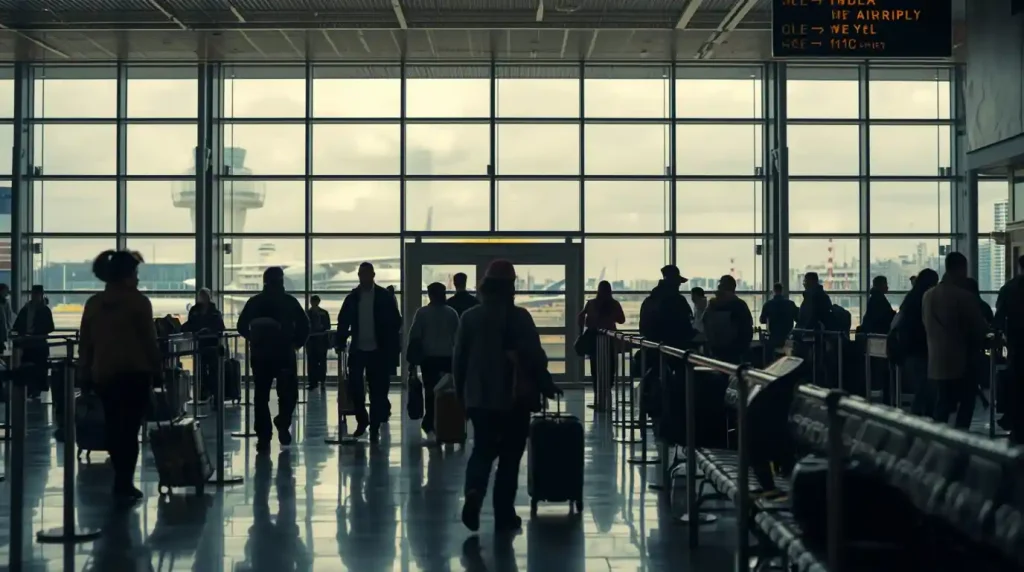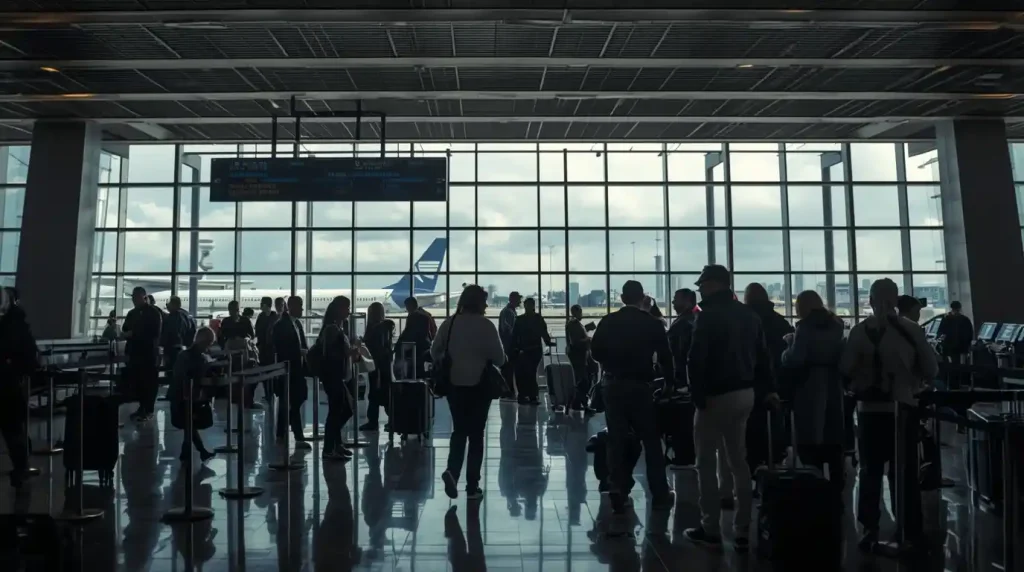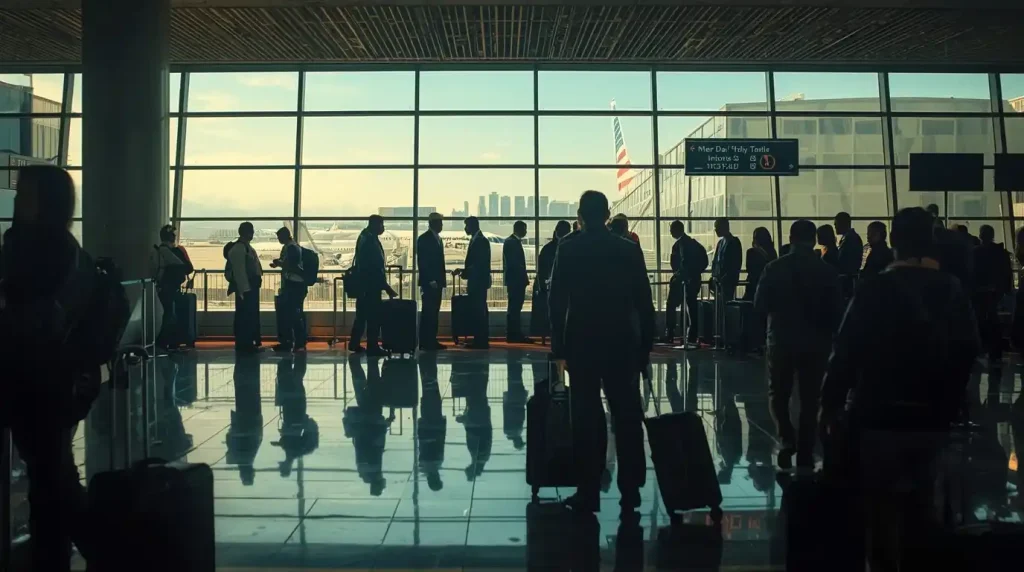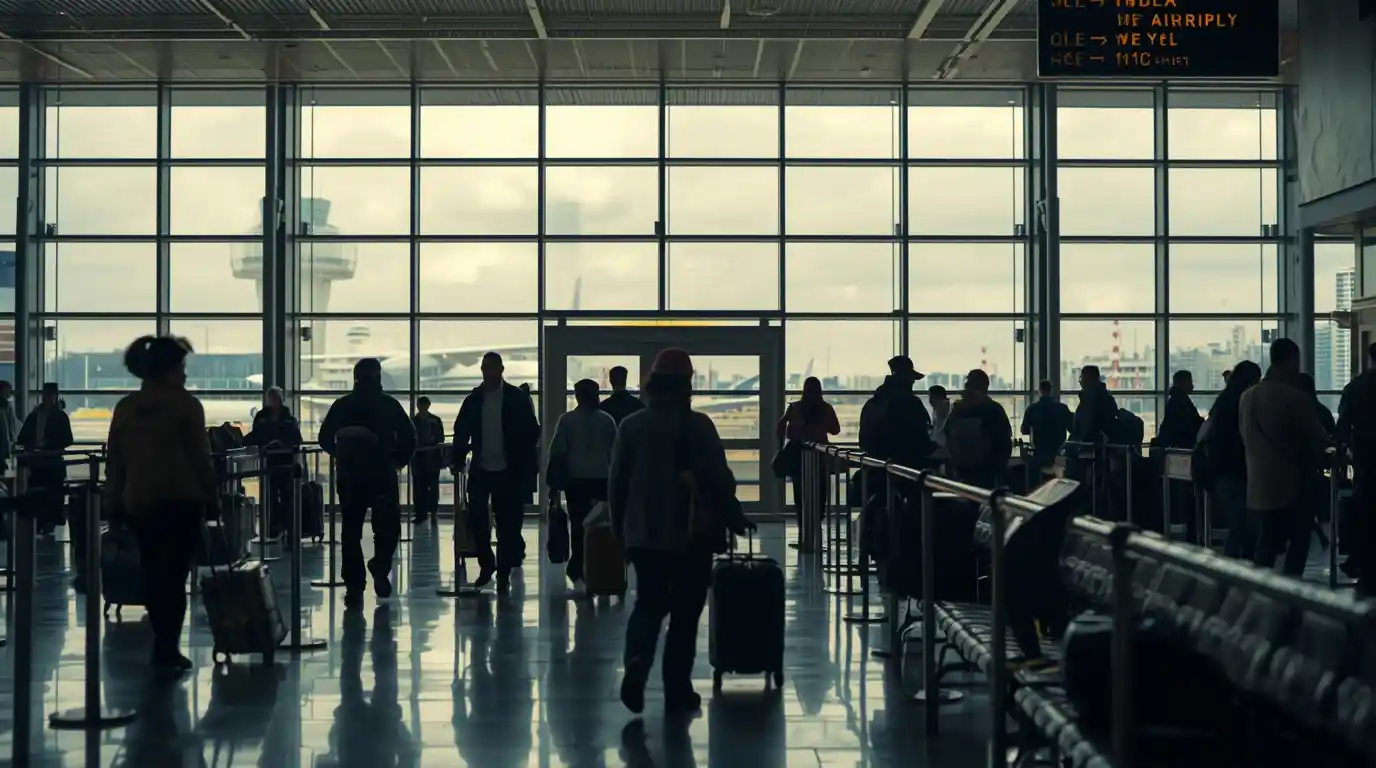A scene becoming all too familiar at major U.S. airports as the government shutdown impacts travelers across the nation.
The fabric of American air travel is fraying at the seams. For the seventh consecutive day, the nation looks on as a political impasse in Washington D.C. cascades into a full-blown crisis for the traveling public. The ripple effects are no longer subtle inconveniences; they are a tidal wave of disruption. The reality is stark and unavoidable: the ongoing government shutdown impacts travelers on a massive, nationwide scale. From Seattle to Miami, Chicago to Dallas, delays are stacking up, terminal lines are stretching into hours, and a sense of frustration is boiling over. This isn’t a forecast; it’s the current state of affairs at major airports across the United States.
1. The Domino Effect: How a Shutdown Cripples Aviation
To understand why this government shutdown impacts travelers so profoundly, one must look at the intricate, interdependent machinery of the U.S. aviation system. It is a network designed for precision and safety, reliant on tens of thousands of federal employees and robust, ongoing oversight. A shutdown freezes this system in place, triggering a domino effect of delays and complications.
The Federal Aviation Administration (FAA), which employs over 45,000 people, sees a significant portion of its workforce furloughed. Those deemed “essential”—like air traffic controllers—are forced to work without a paycheck. This immediate financial pressure creates immense stress and, critically, leads to increased absenteeism. Why report for a high-stress job when you can’t pay your mortgage or buy groceries? This absenteeism is the primary catalyst for the travel chaos we are witnessing.
Furthermore, the shutdown halts vital, long-term projects. The training of new air traffic controllers is suspended, exacerbating a pre-existing staffing shortage. Modernization projects for aging airport infrastructure and navigation technology are put on indefinite hold. This means that even after the shutdown ends, the system will bear the scars for months, if not years, to come. The government shutdown impacts travelers not just in the immediate present, but also by mortgaging the future efficiency and safety of our air travel system.

2. The Human Factor: TSA and CBP Agents Working Without Pay
Perhaps the most visible way the government shutdown impacts travelers is at the security checkpoint. The Transportation Security Administration (TSA) officers and Customs and Border Protection (CBP) agents are on the front lines, and they are bearing the brunt of public frustration while facing unprecedented personal hardship.
These essential federal employees are required to work through the shutdown, but their pay is withheld until funding is restored. The psychological and financial strain is unsustainable. As the shutdown enters its second week, many officers are making difficult calculations: is it worth spending money on gas and tolls to commute to an unpaid job? Should they call in sick to look for temporary work or manage family emergencies caused by the income disruption?
The data is alarming. According to the TSA’s own statistics, the unscheduled absence rate has skyrocketed to 10% at major hubs like Dallas/Fort Worth International Airport and Hartsfield-Jackson Atlanta International Airport, compared to a historical average of around 3%. This directly translates to fewer open security lanes. What was once a 15-minute process now becomes an hour-long ordeal. The government shutdown impacts travelers by creating a vicious cycle: stressed passengers take out their frustration on unpaid TSA agents, leading to lower morale and higher absenteeism, which in turn creates even longer lines and more stressed passengers.
Internal Resource: What to Do If Your Flight is Canceled: A Step-by-Step Guide
3. In the Cockpit and Control Tower: Strained FAA Systems
While the TSA lines are the most visible symptom, the problems run much deeper, into the very systems that guide aircraft through our national airspace. The government shutdown impacts travelers in ways that are often invisible to the naked eye but are critical to safety and efficiency.
Air traffic controllers, also working without pay, are managing the complex flow of aircraft with reduced staffing. When a control tower at a major airport like Jacksonville or a critical en-route center in New York is understaffed, the FAA is forced to implement ground stops and flow programs. This means planes at departing airports are held on the ground to manage the volume of traffic entering a congested airspace. This is the primary driver of the cascading delays being reported across the country.
Moreover, the shutdown halts routine maintenance and certification processes. FAA inspectors who certify new aircraft and oversee the repair and maintenance of existing fleets are largely furloughed. This could delay the introduction of new, more fuel-efficient planes and slow down critical repairs. While safety remains the paramount priority, the system is operating on a razor’s edge, with its resilience being tested daily. The government shutdown impacts travelers by increasing the risk of systemic failures and eroding the safety margins that the aviation industry is built upon.

Air traffic controllers, working without pay, are the unsung heroes preventing total gridlock, but the strain is showing.
4. Beyond the Terminal: Ripple Effects on the Travel Ecosystem
The disruption doesn’t end at the airport perimeter. The ways this government shutdown impacts travelers extend into the entire travel and tourism ecosystem, creating a cascade of economic pain.
- National Parks and Museums: Many of America’s iconic national parks have been forced to close or operate with minimal staff, leading to overflowing trash bins, closed restrooms, and safety hazards. Museums in Washington D.C., like the Smithsonian and the National Gallery of Art, are closed, devastating family vacations and school trips.
- Passport and Global Entry Processing: The Department of State is mostly funded by fees, but a prolonged shutdown can still cause delays in passport processing. More critically, Trusted Traveler Programs like Global Entry and TSA PreCheck® face significant delays as CBP officers are reassigned to essential duties. This means that the very programs designed to expedite travel are being crippled, ensuring that the government shutdown impacts travelers for weeks after it concludes.
- The Hospitality Industry: Hotels, restaurants, and tour operators in destinations reliant on federal sites or air travel are seeing a wave of cancellations. A family that can’t visit the Grand Canyon or the Smithsonian is likely to cancel their entire trip, costing local economies billions of dollars.
5. Traveler’s Guide: Navigating the Chaos
If you have travel plans during this period, being proactive is key. The government shutdown impacts travelers indiscriminately, but you can take steps to mitigate the damage.
- Arrive Extremely Early: The standard two-hour domestic and three-hour international advice is now obsolete. Plan to arrive at the airport at least three hours before a domestic flight and four hours for an international one.
- Leverage Technology: Use your airline’s app for real-time delay information and mobile boarding passes. Check the FAA’s Flight Delay Information page for a system-wide overview.
- Enroll in TSA PreCheck®/Global Entry: While processing is delayed, having these memberships is still the best way to bypass the longest standard security lines. If you’re already enrolled, make sure your Known Traveler Number is in your airline reservation.
- Pack Your Patience (and a Backup Plan): Understand that frontline employees are not at fault. Be courteous to TSA agents, airline staff, and gate agents. Have a backup plan, including charger packs for your devices, snacks, and essential medications in your carry-on.
- Know Your Rights: Familiarize yourself with the Department of Transportation’s rules on flight delays and cancellations. While airlines are not required to compensate for delays due to a government shutdown, it’s still important to understand their rebooking policies.
Internal Resource: 10 Essential Items for Your Carry-On Bag
6. The Economic Fallout: Counting the Billions in Losses
The economic cost of this travel disruption is staggering. The U.S. Travel Association has estimated that previous shutdowns cost the travel sector billions of dollars in lost activity. The current standoff is on track to meet or exceed those figures.
Airlines are burning millions in fuel as planes sit idle on tarmacs waiting for takeoff clearance. They are also facing massive costs from rebooking passengers, providing hotel vouchers for those stranded by cancellations, and dealing with a torrent of customer service complaints. The indirect costs are even higher. Business travel grinds to a halt, stifling productivity and delaying crucial meetings. Tourism dollars evaporate from local economies. The perception of the U.S. as a reliable destination is tarnished on the global stage. The government shutdown impacts travelers and, by extension, the entire economic engine that travel powers.
7. A Look Back: Lessons from Past Shutdowns
This is not the first time the nation has faced this problem. The 2018-2019 shutdown, which lasted 35 days, provides a chilling preview of what could come if the current impasse continues.
During that record-breaking shutdown, TSA absentee rates peaked at over 10%, causing security checkpoint closures at major airports like Miami and LaGuardia. At LaGuardia, the situation became so dire that a “ground stop” was issued due to a lack of air traffic controllers, halting all incoming flights and causing nationwide ripple effects. It was a watershed moment that proved the aviation system could not operate normally under a prolonged funding lapse.
The current situation mirrors those early warning signs. The critical lesson from past shutdowns is that the government shutdown impacts travelers in a non-linear fashion. The first week brings inconveniences; the second week brings systemic strain; and by the third week, the system begins to fracture. We are now entering that critical second phase.

8. Conclusion: When Will the Gridlock End?
The seventh day of this shutdown has made one thing abundantly clear: the political stalemate in Washington has very real and immediate consequences for millions of citizens and visitors. The government shutdown impacts travelers by degrading the world’s most complex aviation system, punishing the dedicated workers who keep it safe, and inflicting billions in damage on the American economy.
The lines at the airport are a physical manifestation of political failure. Every delayed flight, every missed connection, and every frustrated traveler is a testament to a broken process. As the shutdown continues, the risks to safety, economic stability, and public confidence only grow. The question is no longer if the government shutdown impacts travelers, but how much more disruption the American public and the global travel community will be forced to endure before a resolution is found. The system is holding, but just barely. The countdown to a full-blown crisis has well and truly begun.
Table of Contents
Reference Website:
https://edition.cnn.com/2025/10/07/us/shutdown-impacts-travelers
Our Related News Website:
Sports: Sport Flash
World News: The News Grid
Environment News: Eco Alert
Business News: Biz Trend Now
Dailt News: Unbiased Daily
Realm News: Real Time Realm
Retrun to our Homepage
